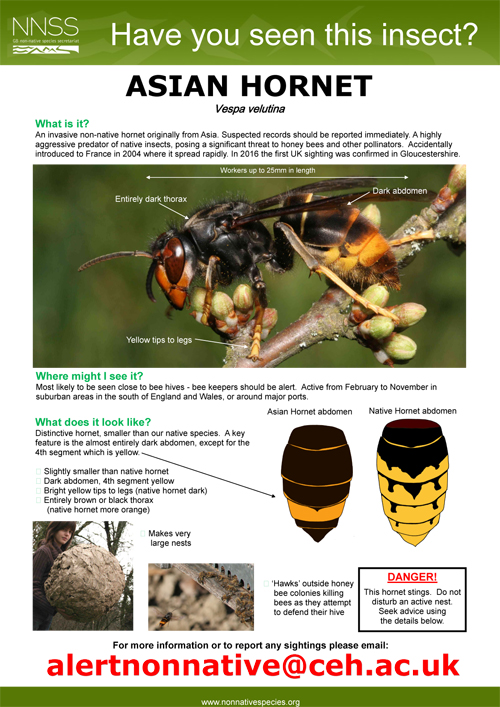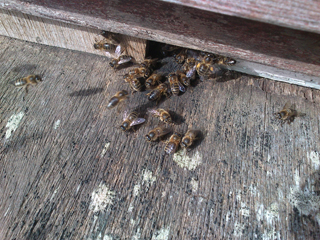 I think it must have been the minute I pressed “Send” on last month’s report to RoL, the honey flow started! Since then, the bees have been going mad in terms of collecting nectar and pollen from this wonderful plant. By storing the nectar, which they then convert to honey, they are guaranteeing their winter stores, something they need to do to allow them to live potentially up to 6 months without having to rely on other external sources of food before the Spring.
I think it must have been the minute I pressed “Send” on last month’s report to RoL, the honey flow started! Since then, the bees have been going mad in terms of collecting nectar and pollen from this wonderful plant. By storing the nectar, which they then convert to honey, they are guaranteeing their winter stores, something they need to do to allow them to live potentially up to 6 months without having to rely on other external sources of food before the Spring.
As for the pollen, the bees not only store this ready for the time when the queen is laying a lot of eggs and the hatching larvae need feeding, but also use it to as food for themselves now. This enables them to build up their fat bodies so they can survive the winter without having to denude their storage areas of pollen. I haven’t seen very much ivy nectar going into the supers as yet, but I’m sure it will come if this flow continues for a few more weeks (as it should do – I remember one year the flow didn’t stop until the first week of December!).
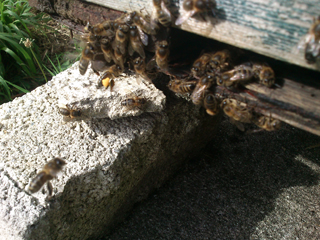 Going back to the honey crop this year. As I have said previously, it was relatively poor compared with the last two years – and many beekeepers I’ve spoken to over the past month have said the same thing. I managed to harvest about one fifth of what I obtained last year and the year before, which is nothing when you consider I am supplying two hotels as well as Veryan Market, friends and family with this wonderful product. Ah well, it’s been one of those years. Everyone I have spoken to about the vegetable garden has also said it’s been an unproductive year compared with most, so perhaps I shouldn’t be too down-hearted – there’s always next year!
Going back to the honey crop this year. As I have said previously, it was relatively poor compared with the last two years – and many beekeepers I’ve spoken to over the past month have said the same thing. I managed to harvest about one fifth of what I obtained last year and the year before, which is nothing when you consider I am supplying two hotels as well as Veryan Market, friends and family with this wonderful product. Ah well, it’s been one of those years. Everyone I have spoken to about the vegetable garden has also said it’s been an unproductive year compared with most, so perhaps I shouldn’t be too down-hearted – there’s always next year!
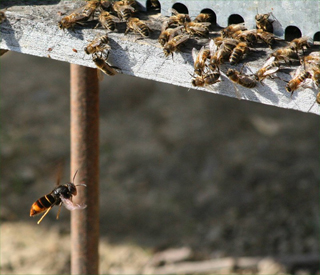 A worse situation than poor honey crops is the (as anticipated) arrival of the Asian Hornet in the UK. It has been found and identified in Gloucestershire, with six sightings within 500m of the first. Steps are being taken to find the nest, which can usually be found high up in the treetops. However, if they came into the UK on board a ship, it is unlikely there will yet be a nest to discover, which in itself makes eradication virtually impossible.
A worse situation than poor honey crops is the (as anticipated) arrival of the Asian Hornet in the UK. It has been found and identified in Gloucestershire, with six sightings within 500m of the first. Steps are being taken to find the nest, which can usually be found high up in the treetops. However, if they came into the UK on board a ship, it is unlikely there will yet be a nest to discover, which in itself makes eradication virtually impossible.
It is very bad news for us beekeepers, who are already suffering from the effects of climate change, habitat loss and insecticide spraying. The Asian Hornet “hawks” in front of the hive entrance and kills bees returning to the hive with their honey-crops full of nectar. This means they are not defending the hive, as would be the case if the hornet attacked the bees at the hive entrance. Some honey bee species, where Asian Hornets are endemic, have solved the problem by attacking the hornet en masse and forming a ball around it.
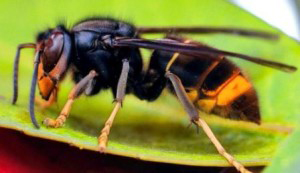 They then raise the temperature at the centre of the ball and basically cook the hornet to death. Cooked hornet on toast, anybody? Unfortunately, our honey bees are not used to this predator and currently have no game plan, so it remains to be seen what happens if no nest is found and the hornet spreads across the UK as it has done in France. I’m not looking forward to that possibility.
They then raise the temperature at the centre of the ball and basically cook the hornet to death. Cooked hornet on toast, anybody? Unfortunately, our honey bees are not used to this predator and currently have no game plan, so it remains to be seen what happens if no nest is found and the hornet spreads across the UK as it has done in France. I’m not looking forward to that possibility.
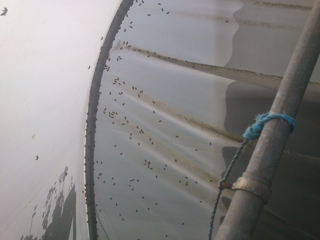 One of my colonies has gone queenless and another has a drone-laying queen, both therefore doomed. This is possibly down to poor mating, whether because of the weather or because of poorly developed or insecticide-affected drones I don’t know. It happens in the beekeeping craft from time to time but coupled with the absconding from the poly hive that I referred to last time, it is becoming a bit of a pain. Not only does it mean I’ve lost these colonies for next year’s harvest but I have to dispose of the comb (either melting or destroying), clean the hive, and store the hive ready for the arrival of swarms in the Spring – but then I’ve got nothing else to do, have I?!!
One of my colonies has gone queenless and another has a drone-laying queen, both therefore doomed. This is possibly down to poor mating, whether because of the weather or because of poorly developed or insecticide-affected drones I don’t know. It happens in the beekeeping craft from time to time but coupled with the absconding from the poly hive that I referred to last time, it is becoming a bit of a pain. Not only does it mean I’ve lost these colonies for next year’s harvest but I have to dispose of the comb (either melting or destroying), clean the hive, and store the hive ready for the arrival of swarms in the Spring – but then I’ve got nothing else to do, have I?!!
Talking of swarms, I had a phone call today saying there was a swarm of honey bees in a poly-tunnel! That’s a first for me, so I am going to have a look tomorrow morning. It all sounds somewhat odd, as the bees are not clustering as they do in a “normal” swarm. They are spread out along and across the metal support poles holding the polythene up, in several small clusters. These would be impossible to collect in the standard way of collecting swarms, so I am thinking about placing a baited bait hive alongside the biggest cluster to try to persuade the bees to enter that. If they do, then I can take the hive away and sort the bees out at home – I have an empty poly hive they might like to occupy!!
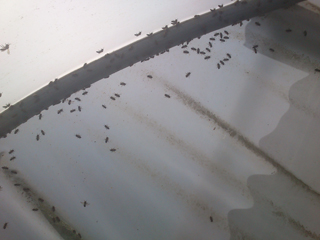 Finally, my autumn course has started, with the maximum I am willing to take. So far, they appear to be a good bunch of students, eager to learn, not afraid to ask difficult questions, and very much discontented with the way things are going in the world, eg Government attitudes to neonicotinoid sprays, Donald Trump as the USA’s next president, the state of the Labour Party and the like! We all get on extremely well together, though it’s sometimes difficult to get them back into class to talk about bees after we’ve had a refreshment break!!
Finally, my autumn course has started, with the maximum I am willing to take. So far, they appear to be a good bunch of students, eager to learn, not afraid to ask difficult questions, and very much discontented with the way things are going in the world, eg Government attitudes to neonicotinoid sprays, Donald Trump as the USA’s next president, the state of the Labour Party and the like! We all get on extremely well together, though it’s sometimes difficult to get them back into class to talk about bees after we’ve had a refreshment break!!
I’ll keep you posted on developments with the poly-tunnel swarm, the Asian Hornet – and my students.
Colin Rees – 01872 501313 – colinbeeman@aol.com


